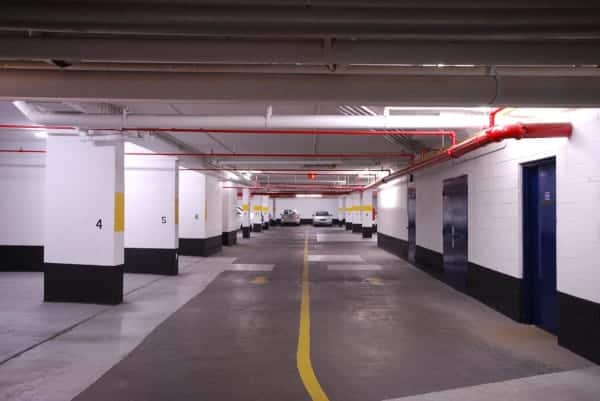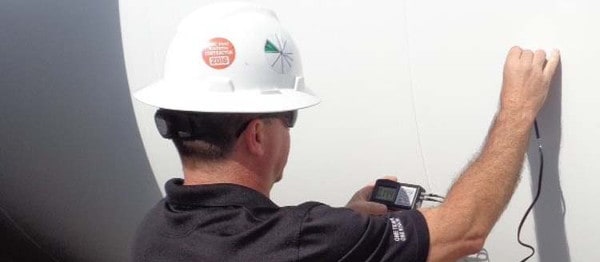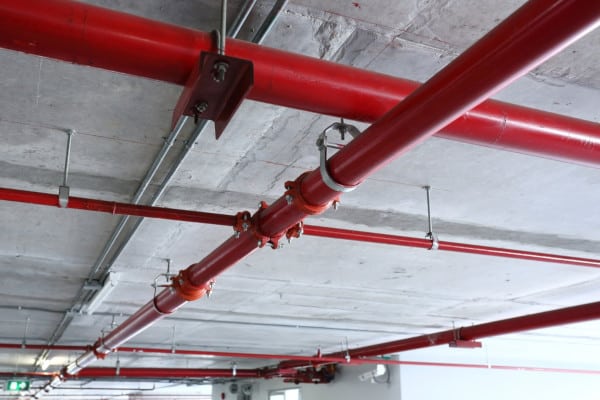Learn the nitty-gritty of conducting obstruction investigations and flushing blocked fire sprinkler pipes
There’s no denying the critical role fire sprinkler systems play in life and fire safety. But if obstructions remain undetected in fire sprinkler pipe and cause a system to fail, a fire can be left to rage on, possibly leading to the devastating loss of property and life.
In the first installment of our two-part series on obstruction investigations in fire sprinkler pipe, we reviewed when investigations should be conducted—including 15 triggers highlighted by the 2020 edition of NFPA 25: Standard for the Inspection, Testing, and Maintenance of Water-Based Fire Protection Systems. We also discussed the most common sources of blockages.
In this blog, we examine how inspections should be carried out and outline standard flushing remedies to unblock fire sprinkler pipes.
Looking to repair or replace obstructed pipes? Browse our selection of pipe and accessories, including CPVC pipe components, pipe hangers, and seismic bracing.
Obstruction investigation 101: Where to inspect fire sprinkler pipe and how to get started
Sprinkler pipes maintain the ultimate poker face: they rarely give visual or other obvious clues that they are blocked until the situation turns dire. For this reason, NFPA recognizes that pipe assessments must be thorough and systematic, and recommends always testing valves, risers, cross lines, and branch mains as the foundation for obstruction investigations.
To gauge whether an obstruction investigation is warranted in any part of the pipe network, begin with a test assessment by opening a flushing connection at one of the main ends. Next, remove the end fitting, a piece of the branch line, or a sprinkler to visibly inspect for foreign organic and inorganic material.
In dry pipe or preaction systems, the 2017 edition of the NFPA 25 Handbook advises inspectors to choose the most remote line from the riser without an inspector’s test valve. When those types of systems are tripped, sediment and scale are most likely to collect at the end of the system, but the branch line with the inspector’s test connection is designed to flush it out. Examining the branch line adjacent to the one containing the inspector’s test connection should paint a more realistic picture of the amount of material hidden in the rest of the system.

When assessing the pipes, inspectors should check for the presence of:
- Debris
- Build-up or the mere presence of rust
- Slime
- Any suspicious organic or inorganic materials
At this early stage, it can sometimes come down to a judgment call as to whether the initial assessment calls for further investigation; however, any foreign matter or significant pipe corrosion could be cause to move on to a more thorough and systematic inspection.
The key to conducting a thorough obstruction investigation is looking in the system where obstructions are most likely to be found. 14.3.2.2 aims to focus investigations on the most important spots, ensuring that none of the main system components are neglected.
From the 2020 Edition of NFPA 25
14.3.2.2* Internal examination shall be performed at the following minimum four points:
(1) System valve
(2) Riser
(3) Cross main
(4) Branch line
Valves can be vulnerable to blockages due to corrosion or foreign objects, but they are also susceptible to becoming stuck (or being left) in a partially closed or open position—so less build-up can cause more blockage at these junctures.
Risers are a key component of sprinkler systems, acting as a bridge between the water supply and the rest of the sprinkler piping network. With so much water flowing through their valves and pipes, they can be a common location for obstructions to settle.
Cross mains travel from feed mains, where water is supplied either directly or through risers. Branch lines are defined in the 2019 edition of NFPA 13: Standard for the Installation of Sprinkler Systems (3.3.19) as “the pipes supplying sprinklers, either directly or through sprigs, drops, return bends or arm-overs.” They branch from cross mains and main lines, are typically of smaller diameter, and supply water directly to sprinkler heads. Both cross mains and branch lines should be examined visually where accessible.
But read this carefully: NFPA 25’s direction is only meant as minimum requirements—it was not designed to limit examinations to these points. If an obstruction is uncovered in one of these locations, it’s wise to open a few other areas of the system to verify whether the problem stands as an isolated incident or is widespread.

Uncovering blockages: fire sprinkler pipe investigation tactics
If unsatisfactory conditions are observed as outlined in Section 14.3, investigations should be made to determine the extent and severity of the obstructing material. NFPA 25 (D.3) offers these tips for getting started:
- Using the fire protection system plan, familiarize yourself with the water-supply sources, the age of underground mains and sprinkler systems, the types of systems, and the general piping arrangements.
- Consider the possible sources of obstruction material.
- Examine the fire pump suction supply and screening arrangements. If necessary, have the suction cleaned before using the pump in investigations and subsequent flushing operations.
- Gravity tanks should be inspected internally. The sole exception: steel tanks that have been recently cleaned and painted. If possible, have the tank drained and determine whether loose scale clings to its shell, or if sludge or other obstructions are on the tank bottom. Cleaning and repainting may be required, particularly if it has not been done within five years.
- In yard main systems, where underground piping around the property helps supply water, investigate the yard main before the sprinkler system.
- If the sprinkler system’s control valves must be closed during investigation procedures, the fire protection impairment precautions outlined in NFPA 25 (Chapter 15) must be followed.
- Large quantities of water are needed for investigation and flushing. It is important to plan the safest means of disposal in advance. Cover stock and machinery susceptible to water damage, and keep equipment on hand for mopping up any accidental discharge of water.
Conducting obstruction investigations on yard mains
Flow water through yard hydrants—preferably near the most remote points of selected mains—to determine whether obstructive material is present. Here’s how NFPA 25 outlines the procedure:
- Connect two lengths of 2 1∕2 in. (65 mm) hose to the hydrant.
- Remove nozzles from the free ends of the hose and attach burlap bags to collect any material that’s flushed out.
- Flow water long enough to determine the condition of the main being investigated.
- If there are several water supply sources, investigate each independently. Do your best to avoid any unnecessary interruptions to sprinkler protection.
- In extensive yard layouts, repeat the tests at several locations to determine general conditions.
- If obstructive material is found, all mains should be flushed thoroughly before moving on to investigating sprinkler systems.

Obstruction investigations on fire sprinkler systems: getting started
NFPA 25 (Annex D) advises property owners to always investigate dry systems first, as they are the most likely source of trouble. Testing several carefully selected, representative systems is generally enough to indicate conditions throughout a property. However, if initial testing indicates the presence of obstructing material, all systems (wet and dry) must be investigated before determining the appropriate flushing operations.
Systems can be considered reasonably free of obstructing material if:
- Less than a 1 ∕2 cup of scale is washed from the cross mains
- Scale fragments are not large enough to plug a sprinkler orifice
- Full, unobstructed flow is obtained from each branch line inspected
Now read this carefully: if other types of foreign material besides scale are found, judgment should be used before considering the system unobstructed. Obstruction potential is based on the physical characteristics and source of foreign material.
When selecting which systems or branch lines to include in the investigation, consider:
- Lines that were identified as obstructed during a fire or maintenance work.
- Systems adjacent to points of recent repair to yard mains, particularly if hydrant flow shows any material in the main.
Obstruction tests should include flows through 2 1∕2 in. (65 mm) fire hose directly from cross mains, as well as flows through 1 1∕2 in. (40 mm) hose from representative branch lines.
Two or three branch lines per system can be considered a representative sample when investigating for scale accumulation. If significant scale is found, additional branch lines should also be tested.
When investigating foreign material other than scale, the number of branch lines needed is determined by the source and characteristics of the foreign material.
If provided, fire pumps should be operated to achieve maximum flow in large lines, with burlap bags ready to collect dislodged material. Each flow should be continued until the water clears, usually at least 2 to 3 minutes at full flow for sprinkler mains. This should be long enough to provide insight into the condition of interior piping.
If obstructions are discovered, steps should be taken to determine the source of the obstructing material and prevent more foreign material in the pipe. For instance, this may entail inspection and cleaning of pump suction screening facilities or cleaning of private reservoirs. If recently laid public mains appear to be the source of the problem, ask waterworks authorities to flush their systems.
Conducting obstruction investigations of dry pipe systems
NFPA 25 outlines the following guidelines:
- Flood dry pipe systems one or two days before conducting an investigation to soften pipe scale and deposits.
- After selecting test points, close the main control valve and drain the system.
- Check the piping visually with a flashlight while it is dismantled.
- Attach hose valves and 1 1∕2 in. (40 mm) hose to the ends of the lines being tested, shut the valves, restore air pressure on the system, and reopen the control valve.
- Open the hose valve on the end branch line, allowing the system to trip in a simulation of normal action.
- Clear any obstructions from the branch line before proceeding with further tests.
- After flowing the small end line, shut its hose valve and test the feed or cross main by discharging water through a 2 1∕2 in. (65 mm) fire hose, collecting any foreign material in a burlap bag.
- After the test, the dry pipe valve should be cleaned internally and reset. Its control valve should be locked open and a drain test should be performed.
Conducting obstruction investigations of wet pipe systems
Testing wet systems mimics dry systems with a major exception: the system must be drained after closing the control valve to permit the installation of hose valves for the test. Once that is done, slowly reopen the control valve and establish the small hose flow to the branch line, followed by the 2 1∕2 in. (65 mm) hose flow for the cross main.
If lines become plugged during testing, piping should be dismantled and cleaned, and the extent of the plugging noted. A clear flow should be obtained from the branch line before proceeding with the rest of the test.
Perform similar tests on representative systems to indicate the general condition of wet systems throughout a facility. Be sure to keep detailed records of any procedures performed.

Alternative obstruction investigation methods
Alternative, non-destructive investigation methods for detecting obstructions can include video and ultrasonic analysis. For a clear look deeper inside systems, a push cable with a small camera and bright lighting can be inserted into valves and risers. Some cross and branch mains can also be examined using video devices. This equipment is helpful for assessing flushing results as well.
Ultrasonic or similar technology can offer an advantage when corrosion is present. It enables the pipe wall to be externally tested to uncover the extent of any deterioration due to microbiologically influenced corrosion (MIC) or other forms of corrosion.
This method offers major benefits—allowing the system to be left in service during the investigation and pinpointing where pipes are about to fail so preventive action can be taken. It also can detect existing air pockets in wet systems as well as trapped sections of pipe in dry systems that aren’t adequately drained and would enable corrosion to flourish.
But ultrasonic technology also has many limitations. While it can detect buildups of sludge, scale, or other byproducts of corrosion, it cannot quantify the severity of the potential obstruction. It can quantify the severity of metal loss but can’t determine the corrosion mechanisms responsible for pipe damage. In most cases, it also struggles to detect the presence of solid materials in piping that are not a byproduct of corrosion, such as wood or plastic, because only small representative sections of pipe are examined. To be thorough, all pipes would require access—even those in concealed spaces like above ceilings.
Ultimately, the type of obstruction investigation that’s chosen should be based on conditions observed during the assessment. For instance, ordering an internal obstruction investigation makes little sense when the observed condition is broken public mains in the vicinity. On the other hand, an internal investigation is warranted when foreign materials are observed in a dry pipe valve.
Watch this video to understand how video inspections can uncover visual evidence of obstructions that could prevent fire sprinkler systems from activating during a fire:
My fire sprinkler pipes are blocked. Now what?
If an obstruction is found in a valve, riser, cross main, or branch main, then the next step is to address the problem where it was discovered. Flushing the system with either water (hydraulic) or air and water (hydropneumatic) is the go-to solution for clearing an obstruction, but the method is somewhat dependent on the source of the blockage.
Generally, NFPA 25 (D.5.2) states that the hydraulic method is enough to satisfactorily flush obstructions comprised of loose sand, mud, or moderate amounts of pipe scale. But if the material is more difficult to remove and available water pressures are too low for effective scouring action, the hydropneumatic method is preferable. Hydropneumatic flushing cannot, however, be used with listed CPVC sprinkler pipes, NFPA 25 warns.
In some cases, when obstructive material is solidly packed or adheres tightly to the walls of the piping, the pipe will have to be dismantled and cleaned by rodding or other means. If a blockage is extensive, pipe or other component replacement may be necessary after flushing.
Protocols that describe specific steps for pre-testing wet and dry sprinkler systems before flushing begin with an inspection of the exterior system parts: the pipe, hangers, and sprinkler heads. The next action is to flush the pipes to find, identify, and clear foreign materials.
Broadly, flushing requires:
- Notifying the fire department, alarm company, and any building personnel that you will be testing the system.
- Draining the system (for wet systems, the main valve must be shut off first; for dry systems, a “pre-flood” is necessary 1-2 days prior to inspection to break up and soften pipe scale).
- Dismantling branch lines and cross mains.
- Flushing and using a burlap bag to collect materials.
- Saving found materials for later inspection.
- Reassembling and ensuring all valves are in the correct position.
- Re-contacting the fire department and alarm companies as well as other property AHJs when the system is back in order.
NFPA (14.3.3) recommends clearing obstructions with a “complete flushing program” performed by qualified individuals. In an NFPA-recommended report by Potter Corrosion Solutions, the degree of pipe obstruction is broken down into three categories:
- Class I — little damage; pipe flushing is sufficient. Hydrostatic testing should also be performed to evaluate leaks and blockages within the system.
- Class II — medium damage; replace the affected pipes.
- Class III — extensive deposits or corrosion; replace multiple pipes and/or other components.
For in-depth guidance on how to navigate Class I, II, or III scenarios, our blog “My Fire Sprinkler Pipes Are Corroded. Now What?” explains strategies for flushing, repair, and replacement.
Watch this video to learn more about flushing sprinkler pipes:
Obstruction investigations spot flaws hiding deep within sprinkler pipes
The key to an obstruction investigation is performing routine assessments and remaining watchful for specific conditions that can indicate corrosion, debris, or blockage. Without attention to blockage prevention, a system—even a newer one, or one that functioned perfectly last year—may be hiding its flaws deep within its pipes. With a proactive approach, sprinkler systems are likely to maintain open pipes and flowing water.
To learn more about when to conduct an obstruction investigation, be sure to check out the first installment in our two-part series: Fire Sprinkler Pipes: How to Perform an Obstruction Investigation, Part 1.
Looking to repair or replace obstructed pipes? Browse our selection of pipe and accessories, including CPVC pipe components, pipe hangers, and seismic bracing.
For more information about QRFS products, call us at +1 (888) 361-6662 or email support@qrfs.com.
This blog was originally posted at blog.qrfs.com. Check us out at Facebook.com/QuickResponseFireSupply or on Twitter @QuickResponseFS.


